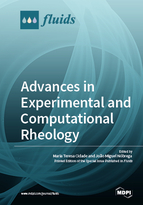Advances in Experimental and Computational Rheology
A special issue of Fluids (ISSN 2311-5521).
Deadline for manuscript submissions: closed (28 February 2019) | Viewed by 61492
Special Issue Editors
Interests: experimental rheology; polymer and polymer-based materials; liquid crystals; biomaterials; emulsions and cementitious suspensions
Special Issues, Collections and Topics in MDPI journals
Interests: computational modelling; computational rheology; polymer processing; viscoelastic fluids; rheology; rheometry; OpenFOAM
Special Issues, Collections and Topics in MDPI journals
Special Issue Information
Dear Colleagues,
Rheology, defined as the science of deformation and flow of matter, is a multidisciplinary scientific field, covering both fundamental and applied approaches. The study of rheology includes both experimental and computational methods, which are not mutually exclusive. Its practical importance embraces many processes, from daily life, like preparing mayonnaise or spread an ointment or shampooing, to industrial processes like polymer processing and oil extraction, among several others. Practical applications include also formulations and product development.
This Special Issue aims to present the latest advances in the fields of experimental and computational rheology applied to the most diverse classes of materials (foods, cosmetics, pharmaceuticals, polymers and biopolymers, multiphasic systems and composites) and processes.
This Special Issue will comprise, not only original research papers, but also review articles.
Prof. Maria Teresa Cidade
Prof. João Miguel Nóbrega
Guest Editors
Manuscript Submission Information
Manuscripts should be submitted online at www.mdpi.com by registering and logging in to this website. Once you are registered, click here to go to the submission form. Manuscripts can be submitted until the deadline. All submissions that pass pre-check are peer-reviewed. Accepted papers will be published continuously in the journal (as soon as accepted) and will be listed together on the special issue website. Research articles, review articles as well as short communications are invited. For planned papers, a title and short abstract (about 100 words) can be sent to the Editorial Office for announcement on this website.
Submitted manuscripts should not have been published previously, nor be under consideration for publication elsewhere (except conference proceedings papers). All manuscripts are thoroughly refereed through a single-blind peer-review process. A guide for authors and other relevant information for submission of manuscripts is available on the Instructions for Authors page. Fluids is an international peer-reviewed open access monthly journal published by MDPI.
Please visit the Instructions for Authors page before submitting a manuscript. The Article Processing Charge (APC) for publication in this open access journal is 1800 CHF (Swiss Francs). Submitted papers should be well formatted and use good English. Authors may use MDPI's English editing service prior to publication or during author revisions.
Keywords
- Experimental rheology
- Computational rheology
- Complex fluids
- Practical applications of rheology







